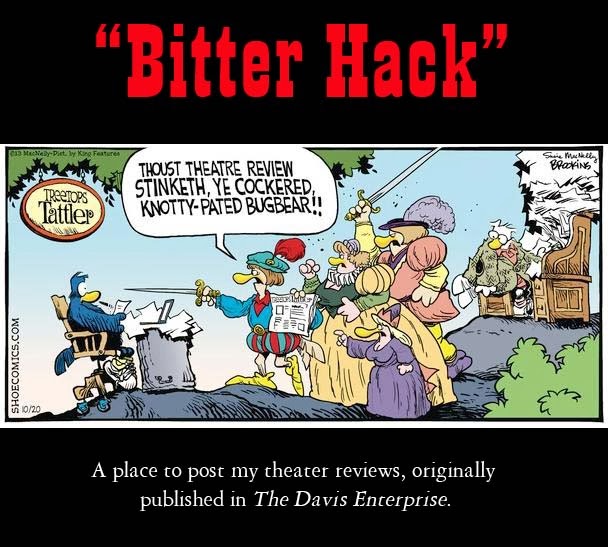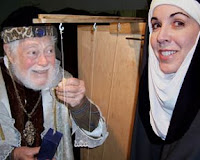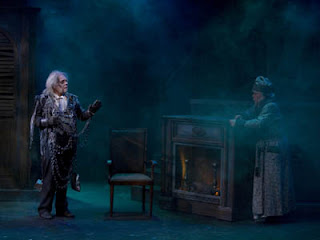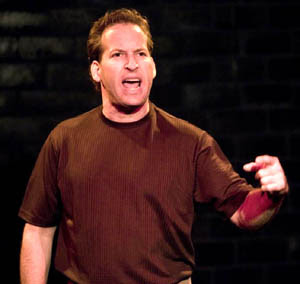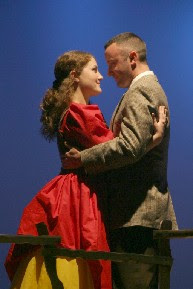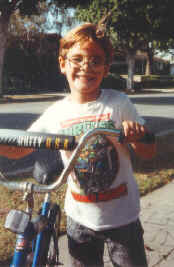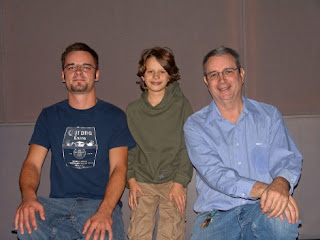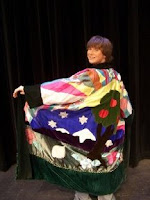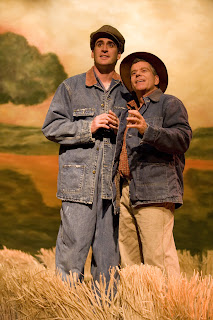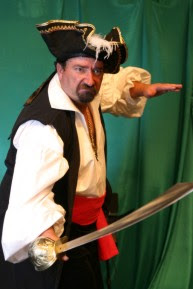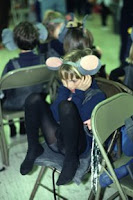 (Photo is of my son Paul,
(Photo is of my son Paul,
in the first production in 1977)
----------------------------------------------------
Davis would be quite a different town if Bob Bowen didn’t like beer and girls.
Bowen was working with the Department of Parks and Recreation at the time of his graduation from Davis High School. He enrolled in UCD as a political science major along with his best friend Tom Eddy (whose father was the manager of one of the banks downtown and whose mother taught in the Davis schools for many years).
As the boys were signing up for classes, Eddy dared Bowen to take a ballet class. Bowen asked what he would get if he accepted the dare. “I seem to remember there was beer involved,” he laughs today.
Bowen enrolled in Jere Curry’s dance class. Curry was delighted to have a male enroll, especially one who seemed to be able to walk and talk at the same time. Bowen weighed the pros and cons of continuing with the class.
“There were 25 women in leotards and me. I could play intramural sports with a bunch of sweaty guys or hang out with some good looking gals.”
Fortunately for the town of Davis, Bowen continued dancing.
In 1972, Roger L. MacDonald contacted his friend Jere Curry to ask for help with a project he was undertaking to raise money for a Sacramento boys’ home (a project which grew into what is now “Best of Broadway”). MacDonald was looking for someone who could perform in a few numbers and act as the emcee for the show. By now Bowen was a regular in Curry’s classes and was even taking lessons Curry taught on the side at the Oddfellows’ Hall. Curry sent Bowen to MacDonald, who immediately cast him.
Over the next few years, Bowen watched MacDonald at work. “I saw the logistics of how you get massive numbers of people on stage and off stage. Doing a small show with a dozen people is one thing; doing a major cattle call with hundreds of people is another. I got a sense of the logistics of how to produce that.”
At the same time, Bowen continued to work part time for the Department of Parks and Recreation and perform with local theater groups. Then the Veterans Memorial theater opened in 1973.
It was like a serendipitous big bang. All the elements fell into place. Bowen been involved in the holiday recreation program for the elementary school kids, when they were out of school in December.
“We would do such things as cooking (which was mildly interesting to some kids, but mostly they were making a mess) or showing movies. (We borrowed 16 mm movies from everybody that we could for free). We also did some basketball, and occasionally took busloads of kids to Sacramento to see the ballet version of ‘The Nutcracker,’ but the program really wasn’t very creative and I was thinking maybe we could do better.”
Then Bowen happened to see an issue of “Women’s Day” magazine and an article about how to put on a production of The Nutcracker for pre-school or elementary school children. A lightbulb went off in his head. “It was a pared down version. It didn’t involve copyright so I could rewrite it (which I did a lot). It doesn’t take full orchestra. It’s just a little stage production.”
The other elements that played into the production of the very first Davis Children’s Nutcracker in 1977 were that since it would be a city production, there were no up front costs for rental of the theater and Bowen had a ready-made crew in the staff of the recreation department.
He was able to twist the arm of some friends Kate Boyce (now Bowen’s wife) and Dina Williams (now Dina Silver) to make simple costumes, burlap tunics over tights for most of the basic costumes. They borrowed a few costumes which had been made by costumers Ann Ough and Marinka Pfaff from the Davis Art Center. Since there was no children’s theater at the time, they were available.
Sets would also be very simple, a chair and a Christmas tree made out of cardboard boxes, with a green tree painted on one side for the party scene and a snow-covered tree on the backside for the fantasy portions of the show.
Bowen put a notice in The Davis Enterprise for children between the ages of 5 and 12 to audition at the Chestnut Park Roundhouse. He didn’t know if anybody would come, and he promised that everyone who auditioned would have some role in the production. In fact, about 50 children showed up.
Scott Cauchois was the prince in the first production (“I eleven years old and was one of the taller guys,” he says). Now a software salesman living in La Jolla with his wife, Scott’s fondest memory was just working with Bob Bowen. “I remember his enthusiasm. He made it a very fun and pleasant experience.”
I myself have a warm spot in my heart for The Davis Children’s Nutcracker because all five of our children performed in the first two productions. In fact my son Ned first met his now wife, Marta Wilson, when both were in the clown group. (To commemorate that meeting, I decorated their wedding cake with clowns and balloons.)
That first show took two weeks to rehearse and only one performance was scheduled. Bowen didn’t know if he could sell all 325 seats in the Vets theater, but he actually over-sold seats and had to turn Mayor Sandy Motley away at the door because she had no ticket and had no child in the production.
Unwittingly, Bowen had started a Davis tradition which is still going strong 30 years later. He continued to direct the shows for the first ten years, at which time his now-wife Kate directed some shows, while Bob continued to act as producer. Kate had graduated from UCD and had been teaching for two years, but needed money and when Bowen suggested she help direct The Nutcracker, the timing worked into her schedule.
“Barbara Wells, my principal at Pioneer School, knew that The Nutcracker was an important community event, so she arranged my schedule so that I could have every afternoon off leading into the show. She always supported any type of children’s theater,” said Kate, adding that “It has come full circle. Pioneer has just built a multipurpose room with a stage and dedicated it to Barbara Wells.”
Others knew the importance of The Nutcracker to the community too. Kids who had been in earlier productions came back to work as leaders for the various groups of children, or to work on the technical aspects of the show.
“It was ‘the thing’ to do on your Christmas vacation,” my daughter Jeri says. “It’s where all your friends were.”
"We were the crew that built The Nutcracker," Ned boasted. "Bob Bowen created the show, and then the tech part of it took off when we showed up." "We" was a group which included his siblings Jeri and Paul, Greg Wershing, Jon, Joel and Chris Lee, Paul Kagiwada, and Phil Sequeira, among others.
Ned is now 40 and is still working backstage at the show, having returned to work with his friend Wershing, who began working backstage when he was 15 and whose sons have now performed in the show for several years.
Jeri explained that “The tech crew was always looking for the ‘oooo’ factor -- how many times an audience said “oooo” during the course of the performance.”
“It was all about upping last year’s performance,” laughed Phil Sequeira, who remembered the “Vegas curtain” year, when Bowen found some glittery curtain and they found a way to use it in the show. “With Bob it was always, ‘we have this cool thing–how can we use it in the show,” explains Ned, remembering when they used a hot air balloon during the soldier/mouse fight scene because Bowen had found a hot air balloon.
Chris Wong (“the eternal Nutcracker guy,” Jeri says) was responsible for building most of the more spectacular effects, like the huge flower that rose up out of the floor with petals that slowly opened to reveal the Sugar Plum Fairy.
“We were insane,” laughed Jeri. “We had the run of the place and we had Bob Bowen who trusted us and was willing to go along with anything we wanted to try” (like drilling holes in the stage floor and filling tubes with flour that they could blast through the holes when a canon supposedly went off).
The popularity of The Nutcracker kept building and by the tenth year the city had to institute a lottery system to cast the show because they had reached the maximum number of kids (200) who could participate.
In 1977 there were 8 groups of clowns, mice, soldiers, Russian dancers, etc. In 2006 there were 18 groups, including some that Tchaikovsky never envisioned, like country line dancers, bees, birds and insects, and gnomes.
By 1997, Bob Bowen’s job duties took him away from what was now the Department of Parks & Community Services and Carrie Dyer took over as producer of The Nutcracker, a job she shared with Marianne Moore, even the year both were pregnant. Dyer continued to produce through 2006. “It’s a lot of work; it’s exhausting, and the rehearsals take a toll on your own family,” she said, “but it started as a work assignment and became something I really loved doing.”
In 2007, Dyer stepped down and turned production duties over to Shannon Clegg and Kristen Hilton. “They worked with me last year and are taking over this year,” she said.
For Sally Hosley, whose three boys have all performed, it is the highlight of her year. “My oldest son is now16 and he has been performing or working with The Nutcracker since he was in the first grade.” She adds that her sons found it a treat to move through the ranks of the show and end up as group leaders.
She credits Ann Smalley, who has directed the show for the past 17 years. “It wouldn’t be what it is without Ann.”
Smalley’s 28 year old daughter was a snowflake at the age of 6 and when the city asked her to help, she readily agreed. “I enjoy theatrical things, I love children and I love music. I love The Nutcracker and I am blessed to be able to do it. I was in right place at the right time. It wouldn’t be Christmas without this in my life. My children grew up with it.”
Ryan Kreidler, the Nutcracker in the current production, is a real pro, having worked his way up from Teddy Bear to Russian Dancer to now the lead in the show. “It’s a lot of stuff to learn, but the fun keeps me coming back,” he said.
“Ann is an incredible lady,” says Laurie Carpenter, whose children have been part of The Nutcracker since they moved from Benicia six year ago. “It’s a way for us to kick off the holidays. We cross our fingers each year. We’ve been fortunate even in the lottery system we’ve been called. I can’t imagine our holidays without it.”
“For anybody who has become a part of The Nutcracker, it remains a part of their lives forever,” said Carrie Dyer.
Bob Bowen still can’t quite believe how his little germ of an idea has blossomed. “Long after all of us are gone it will be quite a legacy to say you did something that takes on a life of its own. I had no idea.”
The city of Davis and hundreds of Davis children owe a debt of gratitude to that challenge that Tom Eddy tossed out to his friend Bob Bowen so many years ago.
 It’s a very special actor who can bring a legendary figure to life and make it believable, without making it a caricature. Some examples are Hal Holbrook’s Mark Twain, Jim Brochu’s Zero Mostel, Philip Seymour Hoffman’s Truman Capote, and Judy Davis’ Judy Garland. Now Janis Stevens has come along and provided us a magnificent Vivien Leigh, currently gracing the stage at Sacramento Theater Company, under the direction of Peter Sander.
It’s a very special actor who can bring a legendary figure to life and make it believable, without making it a caricature. Some examples are Hal Holbrook’s Mark Twain, Jim Brochu’s Zero Mostel, Philip Seymour Hoffman’s Truman Capote, and Judy Davis’ Judy Garland. Now Janis Stevens has come along and provided us a magnificent Vivien Leigh, currently gracing the stage at Sacramento Theater Company, under the direction of Peter Sander.